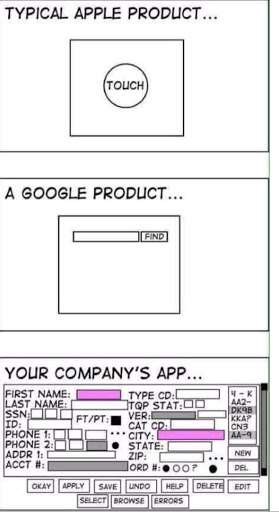App development – Best practice #8 – 10 mistakes to avoid

Whether it is during the design, implementation or development of an application, the mistakes made by the team, the developer or one of the designers can be numerous.
To prevent you from continuing to do them, we have listed here the ten steps that you must absolutely avoid, if you want the production of your app to run smoothly.
 1. Your app is not your website
1. Your app is not your website
Do you already have a website that works quite well? Your project is moving in the right direction, and you’re now planning to launch your app, go to market in the coming weeks/months?
The first mistake you are (perhaps) already about to make, is to take your website’s value proposition, and try to transfer it more or less directly to your app. However, you are not unaware of this: an app and a site are two very different things, and your user does not go on your app for the same reason as on your site.
2. Take the time to choose whether the app should be native, hybrid or web-based.
This is a subject that has already been addressed many times, by our blog but also by the vast majority of actors who evolve in the app world, because it is essential: not to ask the question and launch headlong into the design is a fundamental mistake.
Before you start, you need to define your needs, and, depending on the budget you have, decide to have a native, hybrid, or web app. If you decide to go native, the choice of the marketplace, whose leaders are the App Store and Google Play, also comes into play.
3. Don’t force the user to create an account
It’s happened to you before: you’ve downloaded this application you’ve heard about, and you’re interested in. You open the app, and then, first (big) disappointment: you have no access to any content, no feature of the app, without registering – and give a lot of personal information.
The latter are not even so much the problem, it is rather this convoluted user path that frustrates you. Like 80% of downloaded applications, the one you just opened will be closed after the first use, and never reopened.
4. Do not put too many features
When we develop a project, we are often won over by enthusiasm, and we want to show as much as possible to our users. In the case of an application even more than another project, it is necessary to be concise, precise and never offer too much.
In other words: there is no point in developing an app that solves different problems. On the contrary, it is necessary to focus on one problem, and propose a simple and efficient user path. (As it is the case on this drawing which compares the different user interfaces…)

5. Be careful not to rush onboarding
The onboarding of an app, is the first seconds/minutes that your user will spend on the application just after downloading it. Sometimes, the app opens in a classic way, but it is still recommended to deliver a quick presentation of the offer/service proposed.
Once again, be careful to keep it as simple as possible. It has to go fast and the user has to be able to understand by zapping quickly. That’s why we don’t recommend using animation or videos as an intro: it’s too long, and it gives a rather intrusive advertising aspect. On the contrary, the user must immediately feel at home.
6. Don’t forget to track user activity
When it comes to trackers, the idea isn’t – of course – to recover personal data for resale. This isn’t about that: it’s about analyzing user behaviors – anonymously, to find out how users use the application, what features are used, what doesn’t work…
In order to do that, you need to use tools like Universal Analytics for the Android application, and App Analytics for the IOS version of your app. Don’t delay in implementing these tools, otherwise you will miss valuable information.
 7. Don’t stupidly copy what others do
7. Don’t stupidly copy what others do
You are certainly not alone in your niche – and so much the better, when there is competition, there is a market. It would therefore be quite simple to examine what your competitors are developing and do exactly the same thing again, or almost the same…
However, this is not a good solution: the process of designing a project goes through a whole bunch of iterations, mistakes, which will allow you to find the right solution. This may sound cliché, but in this case, the path is as important as the destination.
Of course, you are interested in the final product, but if you have not iterated beforehand, you will not understand what you have in your hands, nor will you be able to sell it.
8. Don’t forget your marketing plan
The myth of the product or offer that works alone, without any promotional or marketing support exists, but it remains a myth. Unless your name is Elon Musk, you can’t launch an app on the market without letting your potential users know.
And given the plethora of offers that exist, the only solution is to invest part of your budget in marketing and/or promotion.
Warning: an interest-free app will have little chance of working, even if it is well promoted. But a great app will not work without any advertising.
![]() 9. Don’t forget to beta-test
9. Don’t forget to beta-test
The era of “final” products no longer exists. Even the biggest brands are launching their offers/services in versions that we know will evolve over time.
Take the example of the Uber application: the 2019 application has little in common with the one launched 10 years ago in San Francisco. If the design was essentially the same, the product has completely changed.
At first, the app was beta-tested by its first users and early adopters, who allowed design and development teams to provide a more intuitive, efficient experience. And to achieve the international success we are experiencing.
10. Don’t suppose ROI will be immediate
Launching an application costs money, but also time. Above all, this time can increase once the app is released, because users’ adoption time is sometimes longer than expected.
The mistake, in this case, is often to think that if the results are not immediate, the app itself is a failure, and its offer is meaningless. Of course, successes are rarely predictable, and it makes no sense to spend years bailing out a project that does not take off.
But at first, let yourself a few weeks/months to test and federate users before hanging up the gloves because you are not yet profitable.